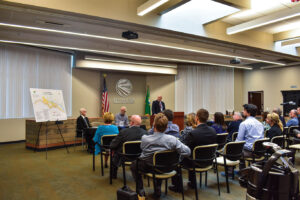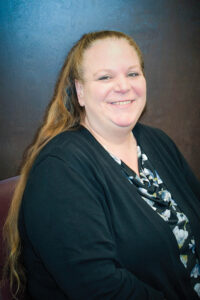Kennewick Irrigation District (KID), nestled in the Tri-Cities area of Washington State, was started in the 1950s. The canal system that KID was formed to build is still in operation today, serving more than 65,000 people. The district has shifted from primarily agricultural land usage to more urban land usage as the Tri-Cities— Kennewick, Pasco, and Richland—have grown. To make that shift successful, the district employs various methods of outreach to engage the public about how their water is used.
In this interview, Dana Hernandez, the customer service supervisor at KID, speaks with Irrigation Leader Managing Editor Joshua Dill about the district’s history, its current public outreach strategy, and the challenges of maintaining a
safe and effective district to serve to the community.

Joshua Dill: Would you tell us about your background and how you came to be in your current position?
Dana Hernandez: I started out working at the front desk of a hotel. I did that for about 5 years and found that I really enjoyed dealing with people and helping them with whatever issues had come up. After that, I went on to a few different jobs, which were more operations-type work. During this time, I earned my bachelor’s degree in business management. When the position at the irrigation district opened, I applied for it because I saw it as an opportunity to get back into working with the public. When I was hired by KID, I started supervising the customer service department because I was quite well versed in dealing with customers. Then, last year, the opportunity came up to be able to supervise and work closely with Shelbea Voelker, our public relations coordinator.
Joshua Dill: Would you give us a quick overview of KID’s history, its service area, and its services?
Dana Hernandez: The district’s roots go back to the late 1800s. The modern KID we know today was formed back in the 1950s, when this area was mostly agricultural land. Our system was built to bring Yakima River water to the Tri-Cities via open canals. As the Tri-Cities have grown, our services have shifted from mainly agricultural to mainly residential services. The district now serves about 25,000 accounts representing over 65,000 people and has 74 miles of canals and over 300 miles of pipeline.
Our system is over 60 years old now, and aging infrastructure poses a challenge. Many of our existing canals have never been lined, though we are aggressively working on doing that now and anticipate having all canals lined in the next 8 years. The district started the lining as a risk-management project because our canals go through the heart of urban centers.
Joshua Dill: Would you tell us about the community outreach events you hold?
Dana Hernandez: Around 5 years ago, we started holding community outreach events at home improvement stores, the county fair, the home and garden show, and the local farmers’ market. It is a way to get in front of the public and to give people the opportunity to approach us and talk with us.
At these events, our operations, engineering, management, and customer service staff, as well as our directors, are on hand. We provide information about when our customers’ water comes on and current and planned projects, and we answer questions. We talk about how our customers can help with water conservation, for example, by using brooms to clean off their driveways instead of hosing them down. We have a kids’ table, too.
We create informational handouts for these events and set up tables where we talk to our customers individually. Right now, the top issues include the electrification of the Chandler Pump Station, title transfer, and canal lining. When we set up our booth this year, we will have handouts to explain what these things are and why we have been working on them for the past several years. The idea is to provide a place where people can come and ask questions.
Joshua Dill: Do you find that people are familiar with what KID does, or is this information new to them?

Dana Hernandez: I think people know that we provide them water, but I don’t think that they all understand where the water comes from or why they have outages in the summer. I also don’t think many people realize that outages can affect entire neighborhoods, not just their individual water supply. In reality, if there is a break in one person’s yard, it can shut down the entire neighborhood. When you have close to 25,000 accounts, one break usually affects a lot of people, and we sometimes have multiple breaks at a time. I do not think that customers understand how big the district is or the scale of the challenges we face during the water season.
Joshua Dill: What questions are most frequently asked?
Dana Hernandez: “When do we get our water?” and “Why don’t we get our water sooner?” are questions that come up a lot in March. KID has a water right that gives us our water no earlier than April 1 each year. Some customers see water in another district’s canal and wonder why that district has water and they don’t. They don’t realize that our water right is different and our water comes from the Yakima River, not the Columbia.
People also want to know why they don’t get refunds for days when there is no water. If your water is off for a week in the summer, we do not lower your bill or give a refund. During times when there is no water, the cost incurred by the district actually increases. We have more staff on hand to fix the issue, parts have to be purchased to do repairs, and additional equipment has to be used to get that water back on. If we refunded customers who were without water each time there was a break, the rest of our customers would have to supplement the cost to restore water to those receiving the refund. When we inform them that KID doesn’t actually charge for water but rather for the delivery system, they sometimes get cranky.
Joshua Dill: What was the specific motivation that led you to begin this program?
Dana Hernandez: Since our district manager, Chuck Freeman, started with the district in November 2009, his goal has been to increase public outreach and to get out in front of our customers. When I started with KID about 6 years ago, it was clear that our focus was to be visible to our customers and to have events where anybody could talk to us and ask questions.
Joshua Dill: Would you also tell us about KID’s school programs?
Dana Hernandez: KID’s school programs have been going on since before I started with the district. KID participates in a program in the Tri- Cities called Safe Kids, in which the fire department, the police department, and the city meet monthly to go over anything that is relevant to the kids in the community. We proposed to the local school districts the idea of coming to the elementary schools and talking about canal safety and why it is important not to swim, play in, or jump over the canals. They accepted, and since then, we have done presentations in the schools’ after-school programs and at the YMCA. We have a PowerPoint presentation that explains why playing in the canal is dangerous.
This year, Shelbea has been working with the assistant superintendent of Kennewick School District to create a new presentation on canal safety that we will present during the school day rather than at after-school programs. That will help us reach all the students.
Joshua Dill: Has KID considered presenting in science classes?

Dana Hernandez: Our focus in the schools is safety, but presentations on the science of irrigation is an interesting idea. The schools have tight schedules dictating what they have to do each day and each week, so getting into the classroom is a challenge. We are willing to present in any class that is available. We are excited to have the opportunity to present in assemblies in which we can talk to the whole student body. The goal is to inform as many kids as we can about canal safety. Kids are playing around in the canals all the time, even when the water comes on. We need to tell them that that is unsafe.
Joshua Dill: Would you tell us about the meetings you hold for the public?
Dana Hernandez: Any time something is going to change for a neighborhood, whether we are putting in new piping, putting in a new system, or pressurizing a system, we try to have as many public meetings with that neighborhood as we can. We find a central location for our meeting, send out emails, and distribute door hangers in that neighborhood to invite residents to come in. We explain the project we are working on and answer questions from the residents so that they understand what we are doing before we start working and disrupting their everyday routines.
We also have a Facebook page that we started a few years ago. During water on, we are posting at least every other day, explaining what our operations crew is working on or informing customers about any problems.
Joshua Dill: What is the benefit for KID of doing these public outreach programs?
Dana Hernandez: Education is the main benefit. I do not think people really understand where their water comes from or how it gets to their property. When they buy a property, a lot of people do not understand that there is a difference between irrigation water and drinking water or the water they use every day.
Joshua Dill: What are your ambitions for the public outreach program in the future?
Dana Hernandez: I hope that we do more. In the past, we have done one event a year. I would like to increase this in 2019 to one event in spring and one in fall, so that we can talk about water startup and water shutdown. I would also like to do more radio spots or get us on the local news or public access television.
Joshua Dill: What advice would you have for other irrigation districts that are thinking about developing their own public outreach programs?
Dana Hernandez: Find a good public relations coordinator who knows how to reach people. Get out and be visible as often as you can. Be available to your customers so that you can constantly talk about what you are doing and what you are improving for your customers. Public outreach is a great resource for continued improvement.
Dana Hernandez is the customer service supervisor at KID. She can be contacted by calling the customer service department at (509) 586-9111 or by emailing customer service at customerservice@kid.org.
